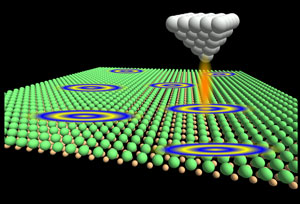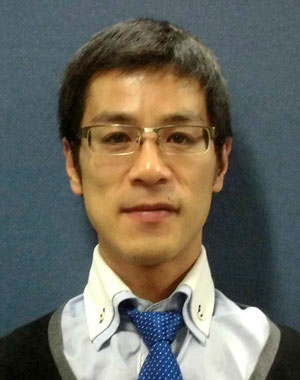Aug. 30, 2019 Research Highlight Physics / Astronomy
Searching for the Majorana quasiparticle in a vortex core
A potential host of the Majorana quasiparticle—a component of quantum computers of the future—has been observed
 Figure 1: The detection of electronic states at a vortex core of a topological superconductor using the tip of a scanning tunneling microscope. © 2019 RIKEN Center for Emergent Matter Science
Figure 1: The detection of electronic states at a vortex core of a topological superconductor using the tip of a scanning tunneling microscope. © 2019 RIKEN Center for Emergent Matter Science
The detection of a zero-energy state in a superconducting material by RIKEN physicists has brought researchers closer to realizing controllable Majorana quasiparticles—particle-like entities that are their own antiparticles1. They are promising for forming the basis of the quantum computers of the future.
The Majorana quasiparticle has recently been observed experimentally in various materials. The challenge now is to create easily controllable Majorana quasiparticles that can be used in quantum computing.
The quasiparticle is thought to exist in vortices that form on superconducting materials since several telltale signs hinting at the presence of Majorana quasiparticles in bound states have been seen.
Now, Tadashi Machida of the RIKEN Center for Emergent Matter Science and co-workers have found strong evidence that the zero-energy states in the vortex cores of the iron-based topological superconductor Fe(Se,Te) may host Majorana quasiparticles.
They used the tip of a scanning tunneling microscope to reveal the zero-energy states on the surface of vortices in Fe(Se,Te). These vortices emerged on applying a magnetic field.
“The material possesses features of a trivial superconductor in the bulk but has the features of a topological insulator at the surface,” says Machida. “As a result, topological superconductivity, and hence Majorana quasiparticles in the vortex cores, may be induced at the surface without the need for any fabrication processes.”
 Tadashi Machida and his co-workers have observed zero-energy states within the surface states of iron-based superconductors, which are potential settings for the Majorana quasiparticle. © 2019 RIKEN
Tadashi Machida and his co-workers have observed zero-energy states within the surface states of iron-based superconductors, which are potential settings for the Majorana quasiparticle. © 2019 RIKEN
The imaging of the zero-energy state requires spectroscopic imaging with an ultrahigh energy resolution. Specifically, the energy resolution of the imaging must be lower than the lowest energy of the trivial bound states, which are also found in the vortex core of topological superconductors.
By using a spectroscopy technique employing a scanning tunneling microscope at ultralow temperatures, Machida and his colleagues achieved a high enough energy resolution to detect the zero-energy state in the presence of bound states (Fig. 1).
Only a fraction of vortices in Fe(Se,Te) host the zero-energy state, and this fraction increases with a decreasing magnetic field. This observation is a vital clue for the control of Majorana quasiparticles — namely that it is important to keep the magnetic field low.
“In Majorana-based quantum computing, it is envisaged that pairs of Majorana quasiparticles function as fundamental quantum bits and the computation can be executed by the exchange of their locations,” says Machida. “Realizing this process is the next challenge.”
“Although there is a long way to go, we believe that our finding is a first step towards moving quantum computing from vision to reality,” he adds.
Related contents
- Topological insulating phase predicted in a new type of material
- Fingerprinting a new class of materials
- Particles that are their own worst enemies
References
- 1. Machida, T., Sun, Y., Pyon, S., Takeda, S., Kohsaka, Y., Hanaguri, T., Sasagawa, T. & Tamegai, T. Zero-energy vortex bound state in the superconducting topological surface state of Fe(Se,Te). Nature Materials 18, 811–815 (2019). doi: 10.1038/s41563-019-0397-1
